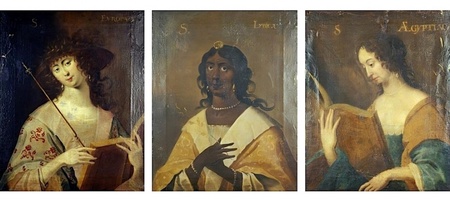An 18th century 'glow up' of paintings representing women around the world has revealed insights into how western standards and male influence changed the perception of beauty through the centuries
The transformation of the Aberdeen Sibyls – a series of paintings depicting female prophets from the ancient world - will be explored as part of celebrations around International Women’s Day.
They were originally gifted to the University of Aberdeen (then King’s College) in 1641 by Principal William Guild.
They hung for many decades in the Common Hall, now the site of King’s College Centre, which was originally adjacent to the Chapel.
The paintings were representations of those who foretold the coming of Christ and were one of the few places women were represented in the University, which was at that time entirely male dominated.
The collection came to the attention of Dr Mary Pryor, the University’s former Head of History of Art and now Senior Academic Skills Adviser in the Centre for Academic Development during her PhD study when she was she was shown a stack of paintings described to her as ‘the pin ups for the lads’ in reference to the place they enjoyed in the Common Hall.
But Dr Pryor quickly discovered that there was much more to the story of the paintings and the fascinating history she uncovered – and what it tells us about changing standards of beauty – is the subject of a free event on March 14.
While it was known that Guild had donated them, the artist who painted the original series of 12 was a mystery. Some theories suggested Aberdonian painter George Jamesone, famous for his of portraits and works for the Scottish Coronation of Charles I, was the artist but no documentation exists to corroborate this.
Then in the 1760s, by which time the paintings were down to 10 and in a state of repair so bad the record reported them as ‘almost quite gone’, Jamesone’s great-great-grandson Cosmo Alexander was hired to restore them.
It is his painting over the originals - the 18th century ‘glow up’ - which plays an important role in our understanding of how beauty standards changed across the centuries.
But showing how this change came about took a chance encounter with medical students and the use of technology more usually used to detect breast cancer as Dr Pryor explains.
“I was teaching medical students as part of an elective and they reported the mystery of the paintings back to their lecturer, a University Professor of Radiology,” she said.
“She then contacted me and offered to X-Ray one of the paintings to see what was underneath. Unfortunately, the results were not good and she concluded the rays were too strong.
“She then suggested we try a mammogram but as it is usually used for breast examination the shape was not well suited to the task and required 18 different images which I then had to piece back together.
“The Sibyls represent women from around the world, so we tried first with Sibyl Europa and then with Sibyl Egyptia, which is the one which yielded truly remarkable results.”
The mammograms showed clear evidence of how the paintings had looked before Cosmo’s makeover.
“Despite the Sibyl’s depicting international women, by the time they had been restored only one was of a black woman.,” Dr Pryor added.
“They were all heavily influenced by Western standards and what were seen as the aspirations of beauty in the 18th century.
“The mammograms revealed that both versions were significantly affected by a male perception of beauty but that this changed across the eras.
“In Sibyl Europa we can see that the original artist followed the 17th century trend of the elongation of the fingers for elegance but that when Cosmo restored them, he rectified what was then seen as a ‘flaw’.
“He restored Sibyl Europa as a powerful woman but also gave her rose bud lips, more of a pout and her cheeks had obviously been rouged, which they would not have been originally.
“Sibyl Egyptia was first painted with quite masculine or severe features, but Cosmo softened these and changed her lips.”
Revealing the original version of Cosmo Egyptia also enabled Dr Pryor to identify the original artist as Jamesone with more certainty.
Using the mammogram image of the 17th century version, she cross referenced Sibyl Egyptia with other models used by Jamesone and found a match in his Ladies of Glenorchy series.
“A technology developed for women’s health has helped us to solve a centuries’ old mystery about who painted these remarkable pictures so intertwined with University history,” Dr Pryor added.
“But more than that, it shows us how much beauty trends change and how perceptions of what is beautiful are heavily influenced by the societies in which we live – and have been for centuries.
“On International Women’s Day, that’s a powerful thing to consider.”
The Sibyl Europa can currently be seen in the exhibition Striking Impressions in the Sir Duncan Rice Library. Places for Dr Pryor’s talk, in conversation with the University’s Dr Helen Pierce can be reserved at https://www.eventbrite.co.uk/e/talk-beneath-the-surface-solving-the-mystery-of-the-aberdeen-sibyls-tickets-819731297377?aff=oddtdtcreator


